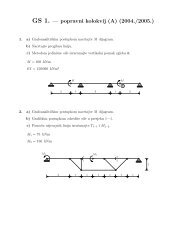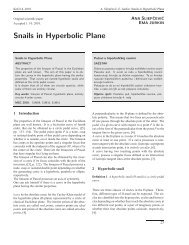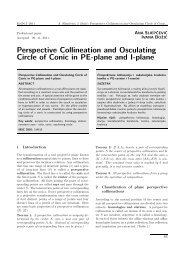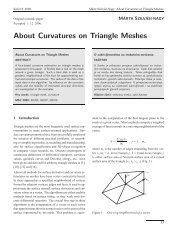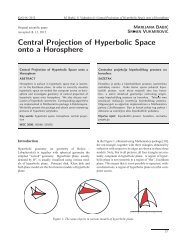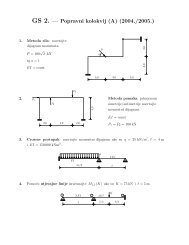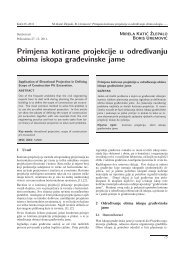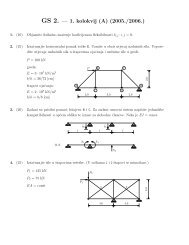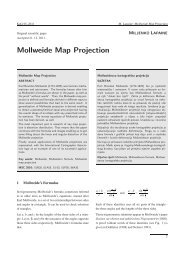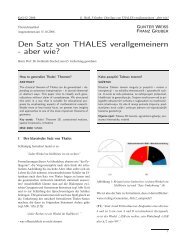Regular Polygons in the Taxicab Plane
Regular Polygons in the Taxicab Plane
Regular Polygons in the Taxicab Plane
Create successful ePaper yourself
Turn your PDF publications into a flip-book with our unique Google optimized e-Paper software.
KoG • 12–2008Orig<strong>in</strong>al scientific paperAccepted 1.12.2008.H. B. Çolakoğlu, R. Kaya: <strong>Regular</strong> <strong>Polygons</strong> <strong>in</strong> <strong>the</strong> <strong>Taxicab</strong> <strong>Plane</strong>H. BARIŞ ÇOLAKOĞLURÜSTEM KAYA<strong>Regular</strong> <strong>Polygons</strong> <strong>in</strong> <strong>the</strong> <strong>Taxicab</strong> <strong>Plane</strong><strong>Regular</strong> <strong>Polygons</strong> <strong>in</strong> <strong>the</strong> <strong>Taxicab</strong> <strong>Plane</strong>ABSTRACTIn this paper, we def<strong>in</strong>e taxicab regular polygons and determ<strong>in</strong>ewhich Euclidean regular polygons are also taxicabregular, and which are not. F<strong>in</strong>ally, we <strong>in</strong>vestigate <strong>the</strong>existence or nonexistence of taxicab regular polygons.Key words: taxicab distance, Euclidean distance, protractorgeometry, regular polygonMSC 2000: 51K05, 51K99.Pravilni poligoni u taxicab ravn<strong>in</strong>iSAŽETAKU radu def<strong>in</strong>iramo pravilne taxicab poligone i odredujemokoji su pravilni euklidski poligoni ujedno i pravilni taxicabpoligoni, a koji nisu. Naposljetku, ispitujemo postojanje il<strong>in</strong>epostojanje pravilnih taxicab poligona.Ključne riječi: taxicab udaljenost, euklidska udaljenost,protractor geometrija, pravilni poligon1 IntroductionA metric geometry consists of a set P , whose elements arecalled po<strong>in</strong>ts, toge<strong>the</strong>r with a collection L of non-emptysubsets of P , called l<strong>in</strong>es, and a distance function d, suchthat1) every two dist<strong>in</strong>ct po<strong>in</strong>ts <strong>in</strong> P lie on a unique l<strong>in</strong>e,2) <strong>the</strong>re exist three po<strong>in</strong>ts <strong>in</strong> P , which do not lie all on onel<strong>in</strong>e,3) <strong>the</strong>re exists a bijective function f : l → R for all l<strong>in</strong>es <strong>in</strong>L such that | f(P) − f(Q)| = d(P,Q) for each pair of po<strong>in</strong>tsP and Q on l.A metric geometry def<strong>in</strong>ed above is denoted by {P,L,d}.However, if a metric geometry satisfies <strong>the</strong> plane separationaxiom below, and it has an angle measure functionm, <strong>the</strong>n it is called protractor geometry and denoted by{P,L,d,m}.4) For every l <strong>in</strong> L, <strong>the</strong>re are two subsets H 1 and H 2 of P(called half planes determ<strong>in</strong>ed by l) such that(i) H 1 ∪ H 2 = P − l (P with l removed),(ii) H 1 and H 2 are disjo<strong>in</strong>t and each is convex,(iii) If A ∈ H 1 and B ∈ H 2 , <strong>the</strong>n [AB] ∩ l ≠ ∅ .The taxicab metric was given by M<strong>in</strong>kowski [8] at<strong>the</strong> beg<strong>in</strong>n<strong>in</strong>g of <strong>the</strong> last century. Later, taxicabplane geometry was <strong>in</strong>troduced by Menger [6], anddeveloped by Krause [5], us<strong>in</strong>g <strong>the</strong> taxicab metricd T (P,Q)=|x 1 − x 2 |+|y 1 − y 2 | <strong>in</strong>stead of <strong>the</strong> well-known Euclideanmetric d E (P,Q)=[(x 1 −x 2 ) 2 +(y 1 −y 2 ) 2 ] 1/2 for <strong>the</strong>distance between any two po<strong>in</strong>ts P = (x 1 ,y 1 ) and Q =(x 2 ,y 2 ) <strong>in</strong> <strong>the</strong> Cartesian coord<strong>in</strong>ate plane (R 2 ). If L E is<strong>the</strong> set of all l<strong>in</strong>es, and m E is <strong>the</strong> standard angle measurefunction of <strong>the</strong> Euclidean plane, <strong>the</strong>n {R 2 ,L E ,d T ,m E } is amodel of protractor geometry, and it is called taxicab plane(see [3], [7]). The taxicab plane is one of <strong>the</strong> simple non-Euclidean geometries s<strong>in</strong>ce it fails to satisfy <strong>the</strong> side-anglesideaxiom, but it satisfies all <strong>the</strong> rema<strong>in</strong><strong>in</strong>g twelve axiomsof <strong>the</strong> Euclidean plane (see [5]). It is almost <strong>the</strong> same as<strong>the</strong> Euclidean plane {R 2 ,L E ,d E ,m E } s<strong>in</strong>ce <strong>the</strong> po<strong>in</strong>ts are<strong>the</strong> same, <strong>the</strong> l<strong>in</strong>es are <strong>the</strong> same, and <strong>the</strong> angles are measured<strong>in</strong> <strong>the</strong> same way. However, <strong>the</strong> distance functions aredifferent. S<strong>in</strong>ce taxicab plane have distance function differentfrom that <strong>in</strong> <strong>the</strong> Euclidean plane, it is <strong>in</strong>terest<strong>in</strong>g tostudy <strong>the</strong> taxicab analogues of topics that <strong>in</strong>clude <strong>the</strong> distanceconcept <strong>in</strong> <strong>the</strong> Euclidean plane. Dur<strong>in</strong>g <strong>the</strong> recentyears, many such topics have been studied <strong>in</strong> <strong>the</strong> taxicabplane (see [10]). In this work, we study regular polygons<strong>in</strong> <strong>the</strong> taxicab plane.2 <strong>Taxicab</strong> <strong>Regular</strong> <strong>Polygons</strong>As <strong>in</strong> <strong>the</strong> Euclidean plane, a polygon <strong>in</strong> <strong>the</strong> taxicab planeconsists of three or more coplanar l<strong>in</strong>e segments; <strong>the</strong> l<strong>in</strong>esegments (sides) <strong>in</strong>tersect only at endpo<strong>in</strong>ts; each endpo<strong>in</strong>t(vertex) belongs to exactly two l<strong>in</strong>e segments; no two l<strong>in</strong>esegments with a common endpo<strong>in</strong>t are coll<strong>in</strong>ear. If <strong>the</strong>number of sides of a polygon is n for n 3 and n ∈ N,27
KoG • 12–2008H. B. Çolakoğlu, R. Kaya: <strong>Regular</strong> <strong>Polygons</strong> <strong>in</strong> <strong>the</strong> <strong>Taxicab</strong> <strong>Plane</strong><strong>the</strong>n <strong>the</strong> polygon is called an n-gon. The follow<strong>in</strong>g def<strong>in</strong>itionsfor polygons <strong>in</strong> <strong>the</strong> taxicab plane are given by meansof <strong>the</strong> taxicab lengths <strong>in</strong>stead of <strong>the</strong> Euclidean lengths:Def<strong>in</strong>ition 1 A polygon <strong>in</strong> <strong>the</strong> plane is said to be taxicabequilateral if <strong>the</strong> taxicab lengths of its sides are equal.Def<strong>in</strong>ition 2 A polygon <strong>in</strong> <strong>the</strong> plane is said to be taxicabequiangular if <strong>the</strong> measures of its <strong>in</strong>terior angles are equal.Def<strong>in</strong>ition 3 A polygon <strong>in</strong> <strong>the</strong> plane is said to be taxicabregular if it is both taxicab equilateral and equiangular.Def<strong>in</strong>ition 2 does not give a new equiangular concept because<strong>the</strong> taxicab and <strong>the</strong> Euclidean measure of an angleare <strong>the</strong> same. That is, every Euclidean equiangular polygonis also <strong>the</strong> taxicab equiangular, and vice versa. However,s<strong>in</strong>ce <strong>the</strong> taxicab plane has a different distance function,Def<strong>in</strong>ition 1 and <strong>the</strong>refore Def<strong>in</strong>ition 3 are new concepts.In this study, we answer <strong>the</strong> follow<strong>in</strong>g question: WhichEuclidean regular polygons are also <strong>the</strong> taxicab regular,and which are not? Also we <strong>in</strong>vestigate <strong>the</strong> existence andnonexistence of taxicab regular polygons.Proposition 1 Let A, B, C and D be four po<strong>in</strong>ts <strong>in</strong> <strong>the</strong>Cartesian plane such that A ≠ B and d E (A,B) = d E (C,D),and let m 1 and m 2 denote <strong>the</strong> slopes of <strong>the</strong> l<strong>in</strong>es AB andCD, respectively.(i) If m 1 ≠ 0 ≠ m 2 , <strong>the</strong>n d T (A,B)=d T (C,D) iff |m 1 | = |m 2 |or |m 1 m 2 | = 1.(ii) If m i = 0 or m i → ∞, <strong>the</strong>n d T (A,B) = d T (C,D) iffm j = 0 or m j → ∞, where i, j ∈ {1,2} and i ≠ j.Proof. We know from [4] that for any two po<strong>in</strong>ts P and Q<strong>in</strong> <strong>the</strong> Cartesian plane that do not lie on a vertical l<strong>in</strong>e, if mis <strong>the</strong> slope of <strong>the</strong> l<strong>in</strong>e PQ, <strong>the</strong>nd E (P,Q) = ρ(m)d T (P,Q) (1)where ρ(m) = (1+m 2 ) 1/2 (1+|m|). If P and Q lie on avertical l<strong>in</strong>e, that is m → ∞, <strong>the</strong>n d E (P,Q) = d T (P,Q).(i) Let m 1 ≠ 0 ≠ m 2 and d E (A,B) = d E (C,D); <strong>the</strong>nby Equation (1), ρ(m 1 )d T (A,B) = ρ(m 2 )d T (C,D). Ifd T (A,B) = d T (C,D), <strong>the</strong>n ρ(m 1 ) = ρ(m 2 ), that is (1 +m 2 1 )1/2 (1 + |m 1 |) = (1 + m 2 2 )1/2 (1 + |m 2 |). Simplify<strong>in</strong>g<strong>the</strong> last equation, we get (|m 1 |−|m 2 |)(|m 1 m 2 |−1)= 0.Therefore |m 1 | = |m 2 | or |m 1 m 2 | = 1. If |m 1 | = |m 2 | or|m 1 m 2 | = 1, <strong>the</strong>n m 2 = m 1 , m 2 = −m 1 , m 2 = 1/m 1 orm 2 = −1/m 1 , and one can easily see by calculations thatρ(m 1 ) = ρ(m 2 ). Therefore d T (A,B) = d T (C,D).(ii) Let m i = 0 or m i → ∞. Then ρ(m i ) = 1. If d T (A,B) =d T (C,D), <strong>the</strong>n ρ(m j ) = 1. Thus, m j = 0 or m j → ∞.If m j = 0 or m j → ∞, <strong>the</strong>n ρ(m j ) = 1, and <strong>the</strong>refored T (A,B) = d T (C,D).□The follow<strong>in</strong>g corollary follows directly from Proposition1, and plays an important role <strong>in</strong> our arguments.Corollary 2 Let A, B and C be three non-coll<strong>in</strong>ear po<strong>in</strong>ts<strong>in</strong> <strong>the</strong> Cartesian plane such that d E (A,B) = d E (B,C).Then, d T (A,B) = d T (B,C) iff <strong>the</strong> measure of <strong>the</strong> angle ABCis π/2 or A and C are symmetric about <strong>the</strong> l<strong>in</strong>e pass<strong>in</strong>gthrough B, and parallel to anyone of <strong>the</strong> l<strong>in</strong>es x = 0, y = 0,y = x and y = −x.Note that Proposition 1 and Corollary 2 <strong>in</strong>dicate also Euclideanisometries of <strong>the</strong> plane that do not change <strong>the</strong>taxicab distance between any two po<strong>in</strong>ts: The Euclideanisometries of <strong>the</strong> plane that do not change <strong>the</strong> taxicab distancebetween any two po<strong>in</strong>ts are all translations, rotationsof π/2 and 3π/2 radians around a po<strong>in</strong>t, reflections aboutl<strong>in</strong>es parallel to anyone of <strong>the</strong> l<strong>in</strong>es x = 0, y = 0, y = xand y = −x, and <strong>the</strong>ir compositions; <strong>the</strong>re is no o<strong>the</strong>r bijectionsof R 2 onto R 2 which preserve <strong>the</strong> taxicab distance(see [9]).3 Euclidean <strong>Regular</strong> <strong>Polygons</strong> <strong>in</strong> <strong>Taxicab</strong><strong>Plane</strong>S<strong>in</strong>ce every Euclidean regular polygon is already taxicabequiangular, it is obvious that a Euclidean regular polygonis taxicab regular if and only if it is taxicab equilateral. So,to <strong>in</strong>vestigate <strong>the</strong> taxicab regularity of a Euclidean regularpolygon, it is sufficient to determ<strong>in</strong>e whe<strong>the</strong>r it is taxicabequilateral or not. In do<strong>in</strong>g so, we use follow<strong>in</strong>g concepts:Any Euclidean regular polygon can be <strong>in</strong>scribed <strong>in</strong> a circleand a circle can be circumscribed about any Euclideanregular polygon. A po<strong>in</strong>t is called <strong>the</strong> center of a Euclideanregular polygon if it is <strong>the</strong> center of <strong>the</strong> circle circumscribedabout <strong>the</strong> polygon. A l<strong>in</strong>e l is called axis ofsymmetry (AOS) of a polygon if <strong>the</strong> polygon is symmetricabout l, and <strong>in</strong> addition, if l passes through two dist<strong>in</strong>ctvertices of <strong>the</strong> polygon <strong>the</strong>n l is called <strong>the</strong> diagonal axis ofsymmetry (DAOS) of <strong>the</strong> polygon. Clearly, every AOS of aEuclidean regular polygon passes through <strong>the</strong> center of <strong>the</strong>polygon.Now, we are ready to <strong>in</strong>vestigate <strong>the</strong> taxicab regularity ofEuclidean regular polygons.Proposition 3 No Euclidean regular triangle is taxicabregular.28
KoG • 12–2008H. B. Çolakoğlu, R. Kaya: <strong>Regular</strong> <strong>Polygons</strong> <strong>in</strong> <strong>the</strong> <strong>Taxicab</strong> <strong>Plane</strong>it is not difficult to see that ∡A 1 = ∡A n+1 = π(n − 1)/n.Thus, <strong>the</strong> constructed 2n-gon is taxicab regular. Fur<strong>the</strong>rmore,on <strong>the</strong> o<strong>the</strong>r side of <strong>the</strong> l<strong>in</strong>e A 1 A 2 , one can constructano<strong>the</strong>r taxicab regular 2n-gon, hav<strong>in</strong>g <strong>the</strong> same l<strong>in</strong>e segmentA 1 A 2 as a side, by us<strong>in</strong>g <strong>the</strong> same procedure (see Figure8).Figure 9Figure 7Figure 10Figure 8Figure 11However, it is easy to see that <strong>the</strong>se two taxicab regular 2ngonsare symmetric about <strong>the</strong> midpo<strong>in</strong>t of <strong>the</strong> l<strong>in</strong>e segmentA 1 A 2 , and <strong>the</strong>y are congruent.□In every taxicab regular 2n-gon, <strong>the</strong>re are n l<strong>in</strong>e segmentsjo<strong>in</strong><strong>in</strong>g <strong>the</strong> correspond<strong>in</strong>g vertices of <strong>the</strong> 2n-gon (A i A ′ i ,1 ≤ i ≤ n, for polygons <strong>in</strong> Figure 7 and Figure 8). Wecall each of <strong>the</strong>se l<strong>in</strong>e segments an axis of <strong>the</strong> polygon.Clearly, axes of every taxicab regular 2n-gon <strong>in</strong>tersect atone and only one po<strong>in</strong>t.Example. Us<strong>in</strong>g <strong>the</strong> procedure given <strong>in</strong> <strong>the</strong> proof of Theorem8, one can easily construct taxicab regular 2n-gons,hav<strong>in</strong>g given any l<strong>in</strong>e segment as a side. To give examples,we construct a taxicab regular quadrilateral (taxicabsquare), a taxicab regular hexagon, and a taxicab regularoctagon, hav<strong>in</strong>g given l<strong>in</strong>e segment AB as a side, <strong>in</strong> Figure9, 10 and 11:5 More About <strong>Taxicab</strong> <strong>Regular</strong> <strong>Polygons</strong>By Proposition 5, we know that every Euclidean squareis taxicab regular, that is, a taxicab square. By Proposition11 below, we will see that every taxicab square is alsoEuclidean regular, that is, a Euclidean square. Thus, <strong>the</strong>Euclidean and <strong>the</strong> taxicab squares always have <strong>the</strong> sameshape, and <strong>the</strong> only regular polygon hav<strong>in</strong>g this property issquare.Proposition 9 Let A, B, C and D be four po<strong>in</strong>ts <strong>in</strong> <strong>the</strong>Cartesian plane such that A ≠ B and d T (A,B) = d T (C,D),and let m 1 and m 2 denote <strong>the</strong> slopes of <strong>the</strong> l<strong>in</strong>es AB andCD, respectively.(i) If m 1 ≠ 0≠m 2 , <strong>the</strong>n d E (A,B)=d E (C,D) iff |m 1 | = |m 2 |or |m 1 m 2 | = 1.(ii) If m i = 0 or m i → ∞, <strong>the</strong>n d E (A,B) = d E (C,D) iffm j = 0 or m j → ∞, where i, j ∈ {1,2} and i ≠ j.31
KoG • 12–2008H. B. Çolakoğlu, R. Kaya: <strong>Regular</strong> <strong>Polygons</strong> <strong>in</strong> <strong>the</strong> <strong>Taxicab</strong> <strong>Plane</strong>Proof. The proof is similar to that of Proposition 1.□The follow<strong>in</strong>g corollary follows directly from Proposition9:Corollary 10 Let A, B, and C be three non-coll<strong>in</strong>earpo<strong>in</strong>ts <strong>in</strong> <strong>the</strong> Cartesian plane such that d T (A,B) =d T (B,C). Then, d E (A,B) = d E (B,C) iff <strong>the</strong> measure of<strong>the</strong> angle ABC is π/2 or A and C are symmetric about <strong>the</strong>l<strong>in</strong>e pass<strong>in</strong>g through B, and parallel to anyone of <strong>the</strong> l<strong>in</strong>esx = 0, y = 0, y = x and y = −x.Proposition 11 Every taxicab square is Euclidean regular.Proof. S<strong>in</strong>ce every side of <strong>the</strong> taxicab square has <strong>the</strong> sametaxicab length and <strong>the</strong> angle between every two consecutivesides is a right angle, by Corollary 10, every side has<strong>the</strong> same Euclidean length. So, every taxicab square is Euclideanequilateral, and <strong>the</strong>refore is Euclidean regular. □We need a new notion to prove <strong>the</strong> next proposition: Anequiangular polygon with an even number of vertices iscalled equiangular semi-regular if sides have <strong>the</strong> same Euclideanlength alternately. There is always a Euclideancircle pass<strong>in</strong>g through all vertices of an equiangular semiregularpolygon (see [11]).Proposition 12 Every taxicab regular octagon, one ofwhose axes is parallel to anyone of <strong>the</strong> l<strong>in</strong>es x = 0, y = 0,y = x and y = −x, is Euclidean regular.Proof. In every taxicab regular octagon, sides have <strong>the</strong>same Euclidean length alternately s<strong>in</strong>ce <strong>the</strong> measure of <strong>the</strong>angle between any two alternate sides is π/2 and sides have<strong>the</strong> same taxicab length, by Proposition 9 and Corollary10. Therefore, every taxicab regular octagon is equiangularsemi-regular. It is obvious that if any two consecutivesides of an equiangular semi-regular polygon have <strong>the</strong>same Euclidean length, <strong>the</strong>n <strong>the</strong> polygon is Euclidean regular.Let us consider a taxicab regular octagon, A 1 A 2 ...A 8 ,one of whose axes, let us say A 1 A 5 , is parallel to <strong>the</strong> l<strong>in</strong>ey = 0, for one case (see Figure 12).Then <strong>the</strong>re exist a Euclidean circle with diameter A 1 A 5 ,pass<strong>in</strong>g through po<strong>in</strong>ts A 1 ,A 2 ,...,A 8 , and <strong>the</strong>re exist a taxicabcircle with center A 1 , pass<strong>in</strong>g through po<strong>in</strong>ts A 2 andA 8 . S<strong>in</strong>ce <strong>the</strong> Euclidean and <strong>the</strong> taxicab circles are bothsymmetric about <strong>the</strong> l<strong>in</strong>e A 1 A 5 , <strong>the</strong> <strong>in</strong>tersection po<strong>in</strong>ts of<strong>the</strong>m, A 2 and A 8 , are also symmetric about <strong>the</strong> same l<strong>in</strong>e.Then two consecutive sides A 1 A 2 and A 1 A 8 have <strong>the</strong> sameEuclidean length by Corollary 10. Therefore, every taxicabregular octagon, one of whose axes is parallel to <strong>the</strong>l<strong>in</strong>e y = 0, is Euclidean regular. The o<strong>the</strong>r cases are similar.□Figure 12Theorem 13 No taxicab regular polygon, except <strong>the</strong> ones<strong>in</strong> Proposition 11 and Proposition 12, is Euclidean regular.Proof. Assume that <strong>the</strong>re exists a taxicab regular polygon,except <strong>the</strong> ones <strong>in</strong> Proposition 11 and Proposition12, that is also Euclidean regular. Then <strong>the</strong>re exists a Euclideanregular polygon, except <strong>the</strong> ones <strong>in</strong> Proposition 5and Proposition 6, that is also taxicab regular. But thisis <strong>in</strong> contradiction with Theorem 7. Therefore, no taxicabregular polygon, except <strong>the</strong> ones <strong>in</strong> Proposition 11 andProposition 12, is Euclidean regular.□6 On <strong>the</strong> Nonexistence of <strong>Taxicab</strong>(2n–1) - gonsThe follow<strong>in</strong>g <strong>the</strong>orem shows that <strong>the</strong>re is no taxicab regulartriangle:Theorem 14 There is no taxicab regular triangle.Proof. Every taxicab equiangular triangle is a Euclideanregular triangle. S<strong>in</strong>ce no Euclidean regular triangle istaxicab regular by Proposition 3, no taxicab equiangulartriangle is taxicab regular. Therefore, <strong>the</strong>re is no taxicabregular triangle.□In addition to Theorem 14, we have seen that <strong>the</strong>re is notaxicab regular 5-gon, 9-gon and 15-gon us<strong>in</strong>g a computerprogram called Compass and Ruler [12]. However, wecould not reach any conclusion by reason<strong>in</strong>g about <strong>the</strong> existenceor nonexistence of taxicab regular (2n − 1)-gonsfor n = 4, n = 6, n = 7 and n ≥ 9. Our conjecture is that<strong>the</strong>re is no taxicab regular (2n − 1)-gon s<strong>in</strong>ce <strong>the</strong>re is nocenter of symmetry of equiangular (2n − 1)-gons. It seems<strong>in</strong>terest<strong>in</strong>g to study <strong>the</strong> open problem: Does <strong>the</strong>re exist anytaxicab regular (2n − 1)-gon?One can also consider <strong>the</strong> generalizations and variationsof our problem. One of <strong>the</strong>m is determ<strong>in</strong><strong>in</strong>g <strong>the</strong> regularpolygons of <strong>the</strong> taxicab space. The taxicab distancebetween po<strong>in</strong>ts P = (x 1 ,y 1 ,z 1 ) and Q = (x 2 ,y 2 ,z 2 ) <strong>in</strong> <strong>the</strong>32
KoG • 12–2008H. B. Çolakoğlu, R. Kaya: <strong>Regular</strong> <strong>Polygons</strong> <strong>in</strong> <strong>the</strong> <strong>Taxicab</strong> <strong>Plane</strong>Cartesian coord<strong>in</strong>ate space (R 3 ) is def<strong>in</strong>ed by d T (P,Q) =|x 1 − x 2 |+|y 1 − y 2 |+|z 1 − z 2 | (see [1]). Clearly, <strong>the</strong> conceptof regular polygon can be def<strong>in</strong>ed similarly <strong>in</strong> <strong>the</strong> taxicabspace; and if regular polygons are determ<strong>in</strong>ed, <strong>the</strong>none can <strong>in</strong>vestigate regular polyhedra <strong>in</strong> <strong>the</strong> taxicab space.This is also <strong>in</strong>terest<strong>in</strong>g subject s<strong>in</strong>ce <strong>the</strong>re are only 5 typesof regular polyhedra <strong>in</strong> <strong>the</strong> three dimensional Euclideanspace. However, <strong>the</strong> results of this work cannot be generalizeddirectly to <strong>the</strong> three dimensional taxicab space s<strong>in</strong>ce<strong>the</strong> taxicab distance is not uniform <strong>in</strong> all directions.References[1] Z. AKCA, R. KAYA, On <strong>the</strong> Distance Formulae <strong>in</strong>Three Dimensional <strong>Taxicab</strong> Space, Hadronic Journal,Vol 27 (2004), No. 5, 521-532.[2] H. B. ÇOLAKOĞLU, R. KAYA, A Syn<strong>the</strong>tic Approachto <strong>the</strong> <strong>Taxicab</strong> Circles, Applied Science(APPS), Vol. 9 (2007), 67-77.[3] B. DIVJAK, Notes on <strong>Taxicab</strong> Geometry, KoG, Vol.5 (2000/01), 5-9.[4] R. KAYA, Area Formula for <strong>Taxicab</strong> Triangles, Pi MuEpsilon Journal, Vol. 12 (2006), 213-220.[5] E.F. KRAUSE, <strong>Taxicab</strong> Geometry; An Adventure <strong>in</strong>Non-Euclidean Geometry, Dover Publications, Inc.,New York, 1986.[6] K. MENGER, You Will Like Geometry, Guildbookof <strong>the</strong> Ill<strong>in</strong>ois Institute of Technology Geometry Exhibit,Museum of Science and Industry, Chicago, IL,1952.[7] R. S. MILMANN, G. D. PARKER, Geometry; A MetricApproach with Models, Spr<strong>in</strong>ger, 1991.[8] H. MINKOWSKI, Gesammelte Abhandlungen,Chelsa Publish<strong>in</strong>g Co., New York, 1967.[9] D. J. SCHATTSCHNEIDER, The <strong>Taxicab</strong> Group,Amer. Math. Monthly, Vol. 91 (1984), No. 7, 423-428.[10] S. S. SO, Recent Developments <strong>in</strong> <strong>Taxicab</strong> Geometry,Cubo Matematica Educacional, Vol. 4 (2002),No. 2, 76-96.[11] http://eom.spr<strong>in</strong>ger.de/p/p073580.htmEncyclopaedia of Ma<strong>the</strong>matics, Spr<strong>in</strong>ger-Verlag,2002.[12] http://mathsrv.ku-eichstaett.de/MGF/homes/grothmann/java/zirkel/doc en/<strong>in</strong>dex.htmlH. Barış Çolakoğlue-mail: bariscolakoglu@hotmail.comRüstem Kayae-mail: rkaya@ogu.edu.trEskişehir Osmangazi UniversityFaculty of Arts and SciencesDepartment of Ma<strong>the</strong>matics26480, Eskişehir, Turkey33



